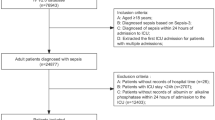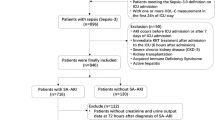Abstract
Ongoing myocardial damage at the acme of the sepsis status has not been sufficiently evaluated. The clinical data of 160 sepsis patients who require intensive care and 127 outpatients with chronic heart failure (HF) were compared as a retrospective cohort study. Thereafter, the sepsis patients were divided into 3 groups according to the serum heart-type fatty acid-binding protein (H-FABP) quartiles [low H-FABP = Q1 (n = 39), middle H-FABP = Q2/Q3 (n = 81), and high H-FABP = Q4 group (n = 40)]. The H-FABP level was measured within 15 min of admission. The serum H-FABP levels in the sepsis patients [26.6 (9.3–79.0) ng/ml] were significantly higher than in the choric HF patients [6.6 (4.6–9.7) ng/ml]. A Kaplan–Meier curve showed that the survival rate of the high-H-FABP group was significantly lower than that of the middle- and low-H-FABP groups. The multivariate Cox regression analysis for the 365-day mortality showed that the high-H-FABP group (hazard ratio: 6.544, 95% confidence interval [CI] 2.026–21.140; p = 0.002) was an independent predictor of the 365-day mortality. The same trend in the prognostic impact was significantly (p = 0.015) observed in the cohort that had not been suffering from the cardiac disease before admission. The serum H-FABP level was an independent predictor of the 365-day mortality in the patients who were emergently hospitalized in the intensive-care unit due to sepsis. Ongoing myocardial damage was detected in the majority of patients with sepsis, suggesting that ongoing myocardial damage might be a candidate predictor of adverse outcomes in sepsis patients.



Similar content being viewed by others
References
Singer M, Deutschman CS, Seymour CW, Shankar-Hari M, Annane D, Bauer M, Bellomo R, Bernard GR, Chiche JD, Coopersmith CM, Hotchkiss RS, Levy MM, Marshall JC, Martin GS, Opal SM, Rubenfeld GD, van der Poll T, Vincent JL, Angus DC (2016) The third international consensus definitions for sepsis and septic shock (sepsis-3). JAMA 315:801–810
Beesley SJ, Weber G, Sarge T, Nikravan S, Grissom CK, Lanspa MJ, Shahul S, Brown SM (2018) Septic cardiomyopathy. Crit Care Med 46:625–634
Repesse X, Charron C, Vieillard-Baron A (2013) Evaluation of left ventricular systolic function revisited in septic shock. Crit Care 17:164
Sato R, Kuriyama A, Takada T, Nasu M, Luthe SK (2016) Prevalence and risk factors of sepsis-induced cardiomyopathy: a retrospective cohort study. Medicine 95:e5031
Lanspa MJ, Gutsche AR, Wilson EL, Olsen TD, Hirshberg EL, Knox DB, Brown SM, Grissom CK (2016) Application of a simplified definition of diastolic function in severe sepsis and septic shock. Crit Care 20:243
Rosjo H, Varpula M, Hagve TA, Karlsson S, Ruokonen E, Pettila V, Omland T, Group FS (2011) Circulating high sensitivity troponin T in severe sepsis and septic shock: distribution, associated factors, and relation to outcome. Intensive Care Med 37:77–85
Bai YL, Hu BL, Wen HC, Zhang YL, Zhu JJ (2018) Prognostic value of plasma brain natriuretic peptide value for patientswith sepsis: a meta-analysis. J Crit Care 48:145–152
Goto T, Takase H, Toriyama T, Sugiura T, Sato K, Ueda R, Dohi Y (2003) Circulating concentrations of cardiac proteins indicate the severity of congestive heart failure. Heart 89:1303–1307
Shirakabe A, Kobayashi N, Hata N, Yamamoto M, Shinada T, Tomita K, Tsurumi M, Matsushita M, Okazaki H, Yamamoto Y, Yokoyama S, Asai K, Shimizu W (2014) Prognostic impact of the serum heart-type fatty acid-binding protein (H-FABP) levels in patients admitted to the non-surgical intensive care unit. Clin Res Cardiol 103:791–804
Zhang ZC, Dai HW, Yu YH, Yang JD, Hu CB (2012) Usefulness of heart-type fatty acid-binding protein in patients with severe sepsis. J Crit Care 27:415.e13–18
Knaus WA, Draper EA, Wagner DP, Zimmerman JE (1985) APACHE II: a severity of disease classification system. Crit Care Med 13:818–829
Reiter M, Twerenbold R, Reichlin T, Mueller M, Hoeller R, Moehring B, Haaf P, Wildi K, Merk S, Bernhard D, Mueller CZ, Freese M, Freidank H, Campodarve Botet I, Mueller C (2013) Heart-type fatty acid-binding protein in the early diagnosis of acute myocardial infarction. Heart 99:708–714
Yamamoto T, Yamamoto A, Watanabe M, Matsuo T, Yamazaki N, Kataoka M, Terada H, Shinohara Y (2009) Classification of FABP isoforms and tissues based on quantitative evaluation of transcript levels of these isoforms in various rat tissues. Biotechnol Lett 31:1695–1701
Arimoto T, Takeishi Y, Shiga R, Fukui A, Tachibana H, Nozaki N, Hirono O, Nitobe J, Miyamoto T, Hoit BD, Kubota I (2005) Prognostic value of elevated circulating heart-type fatty acid binding protein in patients with congestive heart failure. J Card Fail 11:56–60
Shirakabe A, Hata N, Kobayashi N, Okazaki H, Shinada T, Tomita K, Yamamoto M, Tsurumi M, Matsushita M, Yamamoto Y, Yokoyama S, Asai K, Shimizu W (2015) Serum heart-type fatty acid-binding protein level can be used to detect acute kidney injury on admission and predict an adverse outcome in patients with acute heart failure. Circ J 79:119–128
Sato Y, Yamada T, Taniguchi R, Nagai K, Makiyama T, Okada H, Kataoka K, Ito H, Matsumori A, Sasayama S, Takatsu Y (2001) Persistently increased serum concentrations of cardiac troponin T in patients with idiopathic dilated cardiomyopathy are predictive of adverse outcomes. Circulation 103:369–374
Kociol RD, Pang PS, Gheorghiade M, Fonarow GC, O’Connor CM, Felker GM (2010) Troponin elevation in heart failure prevalence, mechanisms, and clinical implications. J Am Coll Cardiol 56:1071–1078
Panteghini M, Pagani F (1994) Diagnostic value of a single measurement of troponin T in serum for suspected acute myocardial infarction. Clin Chem 40:673–674
Niizeki T, Takeishi Y, Arimoto T, Takabatake N, Nozaki N, Hirono O, Watanabe T, Nitobe J, Harada M, Suzuki S, Koyama Y, Kitahara T, Sasaki T, Kubota I (2007) Heart-type fatty acid-binding protein is more sensitive than troponin T to detect the ongoing myocardial damage in chronic heart failure patients. J Card Fail 13:120–127
Latini R, Masson S, Anand IS, Missov E, Carlson M, Vago T, Angelici L, Barlera S, Parrinello G, Maggioni AP, Tognoni G, Cohn JN, Val-He FTI (2007) Prognostic value of very low plasma concentrations of troponin T in patients with stable chronic heart failure. Circulation 116:1242–1249
Gravning J, Askevold ET, Nymo SH, Ueland T, Wikstrand J, McMurray JJ, Aukrust P, Gullestad L, Kjekshus J, Group CS (2014) Prognostic effect of high-sensitive troponin T assessment in elderly patients with chronic heart failure: results from the CORONA trial. Circ Heart Fail 7:96–103
Suzuki S, Motoki H, Minamisawa M, Okuma Y, Shoin W, Okano T, Kimura K, Ebisawa S, Okada A, Kuwahara K (2019) Prognostic significance of high-sensitivity cardiac troponin in patients with heart failure with preserved ejection fraction. Heart Vessels 34:1650–1656
Hamaya R, Horie T, Yonetsu T, Sugano A, Kanaji Y, Usui E, Hoshino M, Yamaguchi M, Ohya H, Sumino Y, Hada M, Hirano H, Kanno Y, Yuki H, Hirao K, Kakuta T (2019) High-sensitivity cardiac troponin decrease after percutaneous coronary intervention in patients with stable coronary artery disease. Heart Vessels 34:948–956
Price S, Anning PB, Mitchell JA, Evans TW (1999) Myocardial dysfunction in sepsis: mechanisms and therapeutic implications. Eur Heart J 20:715–724
Turner A, Tsamitros M, Bellomo R (1999) Myocardial cell injury in septic shock. Crit Care Med 27:1775–1780
Wilhelm J, Hettwer S, Schuermann M, Bagger S, Gerhardt F, Mundt S, Muschik S, Zimmermann J, Bubel S, Amoury M, Kloess T, Finke R, Loppnow H, Mueller-Werdan U, Ebelt H, Werdan K (2013) Severity of cardiac impairment in the early stage of community-acquired sepsis determines worse prognosis. Clin Res Cardiol 102:735–744
Jo YH, Kim K, Lee JH, Rhee JE, Lee JH, Kang KW, Rim KP, Hwang SS, Park HM (2012) Heart-type fatty acid-binding protein as a prognostic factor in patients with severe sepsis and septic shock. Am J Emerg Med 30:1749–1755
Jeong JH, Seo YH, Ahn JY, Kim KH, Seo JY, Kim MJ, Lee HT, Park PW (2016) The prognostic value of serum levels of heart-type fatty acid binding protein and high sensitivity C-reactive protein in patients with increased levels of amino-terminal pro-B type natriuretic peptide. Ann Lab Med 36:420–426
Setsuta K, Seino Y, Ogawa T, Arao M, Miyatake Y, Takano T (2002) Use of cytosolic and myofibril markers in the detection of ongoing myocardial damage in patients with chronic heart failure. Am J Med 113:717–722
Setsuta K, Seino Y, Kitahara Y, Arau M, Ohbayashi T, Takano T, Mizuno K (2008) Elevated levels of both cardiomyocyte membrane and myofibril damage markers predict adverse outcomes in patients with chronic heart failure. Circ J 72:569–574
Davies CH, Harding SE, Poole-Wilson PA (1996) Cellular mechanisms of contractile dysfunction in human heart failure. Eur Heart J 17:189–198
Yan GT, Lin J, Hao XH, Xue H, Zhang K, Wang LH (2009) Heart-type fatty acid-binding protein is a useful marker for organ dysfunction and leptin alleviates sepsis-induced organ injuries by restraining its tissue levels. Eur J Pharmacol 616:244–250
Shirakabe A, Kobayashi N, Hata N, Shinada T, Tomita K, Tsurumi M, Okazaki H, Matsushita M, Yamamoto Y, Yokoyama S, Asai K, Shimizu W (2016) The serum heart-type fatty acid-binding protein (HFABP) levels can be used to detect the presence of acute kidney injury on admission in patients admitted to the non-surgical intensive care unit. BMC Cardiovasc Disord 16:174
Shirakabe A, Hata N, Kobayashi N, Okazaki H, Matsushita M, Shibata Y, Uchiyama S, Sawatani T, Asai K, Shimizu W (2019) Worsening renal failure in patients with acute heart failure: the importance of cardiac biomarkers. ESC Heart Fail 6:416–427
Acknowledgements
We are grateful to the staff of the ICU and medical records office at Chiba Hokusoh Hospital, Nippon Medical School for collecting the medical data.
Funding
None declared.
Author information
Authors and Affiliations
Corresponding author
Ethics declarations
Conflict of interest
The authors declare no conflicts of interest in association with the present study.
Additional information
Publisher's Note
Springer Nature remains neutral with regard to jurisdictional claims in published maps and institutional affiliations.
Rights and permissions
About this article
Cite this article
Tani, K., Shirakabe, A., Kobayashi, N. et al. The prognostic impact of the serum heart-type fatty acid-binding protein level in patients with sepsis who were admitted to the non-surgical intensive-care unit. Heart Vessels 36, 1765–1774 (2021). https://doi.org/10.1007/s00380-021-01865-4
Received:
Accepted:
Published:
Issue Date:
DOI: https://doi.org/10.1007/s00380-021-01865-4




